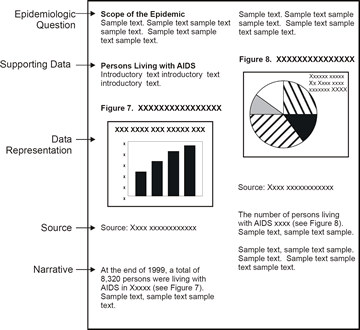Section 2: Determining the Content and Organization of the Profile
To be useful for prevention and care planning, a full
epidemiologic profile should answer several core epidemiologic questions:
- What are the sociodemographic characteristics of the
general population in your service area?
- What is the scope of the HIV/AIDS epidemic in your
service area?
- What are the indicators of risk for HIV infection and
AIDS in the population covered by your service area?
It should also answer questions specific to prevention
or care planning needs, such as
- What are the patterns of service utilization of HIV
infected persons in your area?
- What are the number and characteristics of persons who
know they are HIV-positive but who are not receiving primary HIV medical care?
The material should be contained in sections organized
in a logical sequence that allows end users to locate information quickly.
Chapter 3
explains how to answer the core questions and the questions specific to care programs.
The remainder of this section describes the organizational framework of an effective
and user-friendly profile.
Profile Sections and Organization
As is true of any good document, a well-organized
profile is divided into logical sections:
- front matter
- introduction
- body
- conclusion
- appendixes
- other back matter
Front matter
The front matter should consist of the following:
- Contributors, a list that includes the names of
writers and others who worked on the profile
- Abbreviations, a list of the shortened names for terms
and organizations that appear in the profile
- Executive summary, a synopsis of the profile’s content
- Table of contents, a listing of, and page numbers for,
topics, tables, and figures
Introduction
The introduction should include the following:
- Background about the history and purpose of the
profile
- General description of data sources and their
strengths and limitations to ensure that users understand what the profile can and cannot explain
- Overall description of the profile’s strengths and
limitations
- Preparation information that describes the development
guidelines, process, key players, and how the development of the profile followed
the guidelines and process
Body
The body of the profile includes the epidemiologic
questions and the data that answer the questions.
Data are typically presented in tables, graphs, pie
charts, or maps. These presentations should be accompanied by a narrative that explains and
expands upon the data.
Figure 2-1 illustrates the content requirements of a
page in the profile. No particular page layout for the profile is preferred. The one below is
just an illustration.
Figure 2-1. Example of layout of profile body

Conclusion, appendixes, and other back matter
The back matter should consist of the following:
- The Conclusion summarizes the data and trends and
highlights key findings.
- Appendixes contain information on data sources,
supporting documentation, and a feedback form for end users to complete and return to
the authors.
- Other back matter (in addition to the appendixes)
includes items such as a glossary and a list of references or suggested readings.
Go
to Chapter 2, Section 3
|